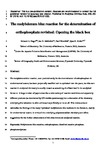The molybdenum blue reaction for the determination of orthophosphate revisited: Opening the black box
| dc.contributor.author | Nagul, EA | en |
| dc.contributor.author | McKelvie, ID | en |
| dc.contributor.author | Worsfold, P | en |
| dc.contributor.author | Kolev, SD | en |
| dc.date.accessioned | 2016-02-22T11:46:40Z | |
| dc.date.available | 2016-02-22T11:46:40Z | |
| dc.date.issued | 2015-08-26 | en |
| dc.identifier.issn | 0003-2670 | en |
| dc.identifier.uri | http://hdl.handle.net/10026.1/4352 | |
| dc.description.abstract |
The molybdenum blue reaction, used predominantly for the determination of orthophosphate in environmental waters, has been perpetually modified and re-optimised over the years, but this important reaction in analytical chemistry is usually treated as something of a 'black box' in the analytical literature. A large number of papers describe a wide variety of reaction conditions and apparently different products (as determined by UV–visible spectroscopy) but a discussion of the chemistry underlying this behaviour is often addressed superficially or not at all. This review aims to rationalise the findings of the many 'optimised' molybdenum blue methods in the literature, mainly for environmental waters, in terms of the underlying polyoxometallate chemistry and offers suggestions for the further enhancement of this time-honoured analytical reaction. | en |
| dc.format.extent | 60 - 82 | en |
| dc.language.iso | en | en |
| dc.publisher | Elsevier Masson | en |
| dc.subject | Molybdenum blue reaction | en |
| dc.subject | Orthophosphate | en |
| dc.subject | Dissolved reactive phosphorus | en |
| dc.subject | Phosphomolybdate | en |
| dc.title | The molybdenum blue reaction for the determination of orthophosphate revisited: Opening the black box | en |
| dc.type | Journal Article | |
| plymouth.author-url | http://gateway.webofknowledge.com/gateway/Gateway.cgi?GWVersion=2&SrcApp=PARTNER_APP&SrcAuth=LinksAMR&KeyUT=WOS:000360646100005&DestLinkType=FullRecord&DestApp=ALL_WOS&UsrCustomerID=11bb513d99f797142bcfeffcc58ea008 | en |
| plymouth.volume | 890 | en |
| plymouth.publication-status | Published | en |
| plymouth.journal | Analytica Chimica Acta | en |
| dc.identifier.doi | 10.1016/j.aca.2015.07.030 | en |
| plymouth.organisational-group | /Plymouth | |
| plymouth.organisational-group | /Plymouth/Faculty of Science and Engineering | |
| plymouth.organisational-group | /Plymouth/Research Groups | |
| plymouth.organisational-group | /Plymouth/Research Groups/BEACh | |
| plymouth.organisational-group | /Plymouth/Research Groups/Marine Institute | |
| plymouth.organisational-group | /Plymouth/Users by role | |
| dcterms.dateAccepted | 2015-07-23 | en |
| dc.rights.embargodate | 2017-08-26 | en |
| dc.rights.embargoperiod | 12 months | en |
| rioxxterms.versionofrecord | 10.1016/j.aca.2015.07.030 | en |
| rioxxterms.licenseref.uri | http://www.rioxx.net/licenses/under-embargo-all-rights-reserved | en |
| rioxxterms.licenseref.startdate | 2015-08-26 | en |
| rioxxterms.type | Journal Article/Review | en |


